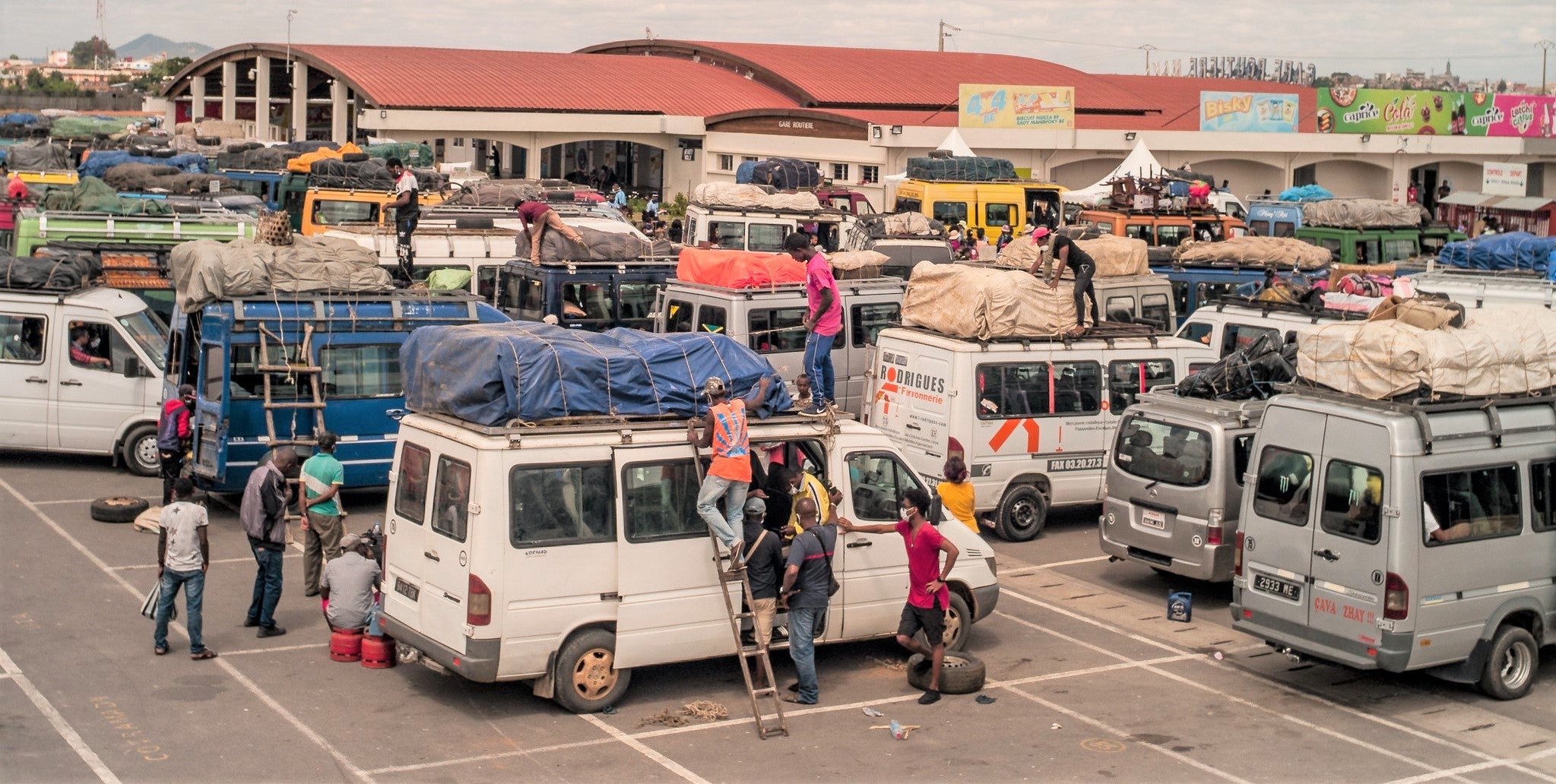 À la gare routière d’Antananarivo, la capitale de Madagascar, ces travailleurs repartent chez eux faute d’avoir pu trouver de quoi faire vivre leur famille à cause d’un confinement prolongé. Alors que les pays les plus pauvres du monde cherchent à relancer leur croissance et redonner du travail à un maximum de personnes, l’adoption d’une stratégie visant à « reconstruire en mieux » se justifie pleinement. (Photo : Henitsoa Rafalia / Banque mondiale)
À la gare routière d’Antananarivo, la capitale de Madagascar, ces travailleurs repartent chez eux faute d’avoir pu trouver de quoi faire vivre leur famille à cause d’un confinement prolongé. Alors que les pays les plus pauvres du monde cherchent à relancer leur croissance et redonner du travail à un maximum de personnes, l’adoption d’une stratégie visant à « reconstruire en mieux » se justifie pleinement. (Photo : Henitsoa Rafalia / Banque mondiale)
It is a catchy acronym. An alliterative call to action. It rolls off the tongues of world leaders like UK Prime Minister Boris Johnson and US President Joe Biden. Building Back Better—or BBB—is the seeming light at the end of the COVID-19 tunnel. But what does BBB really mean in the world’s poorest countries? And how can these countries—which are supported by the World Bank’s International Development Association (IDA)—secure the resources they need to make it happen?
The term BBB was officially coined six years ago at the Sendai Conference on Disaster Risk Reduction – a holistic a notion of resilience through well-balanced disaster risk-reduction measures, from rebuilding infrastructure to revitalizing livelihoods, and from kickstarting growth to restoring local culture and environment.
Then around three years ago, the World Bank launched its BBB Report, outlining how to build back from disasters in ways that are stronger (more productive and resilient), faster (limiting the impact of shocks), and more inclusive (ensuring nobody is left behind). The report showed how BBB tools such as financial preparedness and adaptive social protection can reduce disaster impacts by one-third, saving the world around $170 billion annually in avoided damages, in addition to their broad economic benefits.
Building Back Better from COVID-19
Then hit the calamity of COVID-19, and BBB joined the everyday lexicon for all of us. Countries now face the dual challenge of repairing as quickly as possible the historic damage to development gains and adapting to profound changes transforming the world.
Now, BBB has come to mean the pursuit of a greener, more inclusive and resilient recovery from the COVID-19 crisis. These related elements are essential for countries to make progress toward the Sustainable Development Goals in a world where shocks occur more frequently, with cascading impacts, making resilience and inclusion critical to withstand them.
While specific conditions vary across IDA countries, the crisis has highlighted three fundamental needs going forward:
First, in the face of recession, mass unemployment, and changes to behaviors, trade, and supply chains, countries need to find ways to jumpstart growth and put large numbers of people back to work in ways that are greener, leverage technology, and seize new opportunities.
Second, in the face of mass poverty and exclusion compounded by crises, there is a need to build equity and inclusion and address structural inequalities, including by leveraging technology for the delivery of more robust and inclusive social services (health, education, and social protection) that leave nobody behind.
And third, the crisis has highlighted the role of government and the need to pursue policies, investments and reforms to tackle an increasingly complex agenda to achieve economic, environmental and social sustainability.
Compelling Reasons for IDA Countries to Pursue a BBB Approach from the Get-Go
Such an approach enables countries to:
- Maintain a line of sight to long-term development goals, which is critical even when focusing on saving lives and livelihoods. For example, well-designed public works programs can generate employment, sustain livelihoods, and complement policies and investments to green sectors over time. Similarly, a focus on technology in education can both mitigate learning losses and help address the longer-term learning crisis.
- Optimize the benefits of stimulus and recovery packages by focusing on areas that foster both fiscal and environmental sustainability. For example, low fuel prices present an historic opportunity to reform perverse incentives and reallocate budgets toward social expenditure and greener investments, while aligning market expectations and crowding in private investment for a greener future.
- Drive progress towards their climate change objectives, while tackling the climate dimensions of food security and strengthening climate resilience at the local level.
- Strengthen their own systems to prevent new pandemics and respond to shocks and stressors, such as natural disasters and conflict. This entails targeting resources to vulnerable areas where exclusion, fragility, conflict, violence, and climate impede inclusive growth.
BBB investments generate large economic benefits, but often have significant up-front costs. Studies of transport, energy, and water systems, for example, suggest that each $1 invested in making new infrastructure assets more resilient saves more than $4 over the lifetime of the assets. Similarly, expanding social protection systems brings long-term economic benefits, resilience and self-reliance to their beneficiaries: but they take effort and investment, including social registries and delivery mechanisms.
In the long term, BBB approaches also help to rebalance public finances and improve debt sustainability. But they rely on affordable financing to absorb the upfront costs in order to benefit from the savings over time.
The Resources Challenge Looms—But There Are Promising Signs
BBB requires finance well beyond what the poorest countries can mobilize on their own or what development partners are currently providing. Raising the resources needed to regain lost ground and adapt to the new world will be a monumental challenge , especially given falling domestic resources, increased debt, and tighter capital market access. Overall external financing needs for these countries are projected to be significantly higher in the coming years than in the past. Countries with large fiscal deficits or debt burdens are particularly vulnerable, especially those at high risk of debt distress who desperately need grant financing.
Mobilizing resources for BBB will not be easy, with pressures on finance around the world and with donor governments facing their own extraordinary constraints. A welcome signal late last year was the G20 commitment to deepen support to developing countries as they face the intertwined health, economic, and social effects of COVID-19. Another promising sign is the progress underway to acquire and deliver vaccines to the developing world. The next big test will be whether the international community can kickstart an ambitious IDA20 replenishment this year—because the poorest countries cannot build back better without it.
The blog is part of a series on ways to ensure a resilient recovery from COVID-19 in the world’s poorest countries. For the latest, follow @WBG_IDA and #IDAWorks.
RELATED
The World Bank Group’s Response to the COVID-19 (coronavirus) Pandemic



Join the Conversation